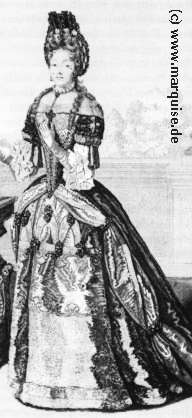| INDEX | 1300-1599 | 1600s | 1700s | 1800s | 1900s | CROSS-ERA | ETHNO | |
| MISCELLANY | CONTACT | SEARCH | |
|
|

The Duchesse d'Orléans by Antoine Trouvain, c. 1700
The costumes of first two decades of the 18th century looked
very much like those of the 1690s:
Ladies wore the manteau (or mantua, as it is commonly known
in English), a loose gown that had developed out of deshabillé
(undress), i.e. a dressing gown. The manteau was draped and
pleated to shape in back and worn open in front with a richly
embroidered stomacher to show in the gap. The absence of shaping
seams made the gown easy to adjust to later fashions, which
is why only very few survived to be examined. The front edges
of the skirt were gathered up and to the back where they were
held by loops around buttons and created an elegant "waterfall"
train.
The lady here, however, is in court dress (grande parure) which features a stiff, back-lacing bodice with short sleeves and an overskirt gathered away to the side, held by two ribbons or brooches on either side at about mid-thigh and below-knee level. The length of the train was reglemented and a status symbol. The décolleté was typically oval with the straps low on the shoulder, a shape popular since the 1660s. Sleeves were short.
In day wear (i.e. the aforementioned mantua), the dress was worn back on the shoulder from the 1680s; sleeves lengthened to almost elbow level and remained so for the following decades. No matter how long the sleeves were, those of the chemise always were longer. Elbow-length gloves were worn often. The mantua was, with only slight variations, worn until the 1720son the Continent and throughout the century in England.
The petticoat (jupe) was at first supported only by more petticoats and a bumroll, later on (c.1715) by the very first, cone-shaped hoop skirts. As it showed under the robe or manteau, it was made of expensive fabric and richly decorated with horizontal rows of embroidery or garniture.
A typical feature of this era (since the late 1680s, in fact)
is the towering hairdo made of locks piled up above the forehead
- the main hair covered with a bonnet at the back of the head
- and surmounted by a wire device covered in lace. Contemporaries
called that kind of cap a commode and the accompanying
hairstyle fontange; nowadays the term fontange is often
used for the cap as well. The overall effect was that of a forward-leaning
tower that always reminds me of a very interested cat.
After its height (literally) in the 1690s, fontanges became
smaller, then ended up (c.1730) as a bonnet with the ribbons
hanging loosely down over back and shoulders.
| <<<COVER PAGE | NEXT >>> |
The music is Chantons, chantons, et nous réjouissons from the opéra-ballet Les Festes vénitiennes (1710) by André Campra. Sequenced by yours truly.
Content, layout and images of this page
and any sub-page of the domains marquise.de, contouche.de, lumieres.de, manteau.de and costumebase.org are copyright (c) 1997-2022 by Alexa Bender. All rights reserved. See Copyright Page. GDPO
This work is licensed under a Creative Commons License.